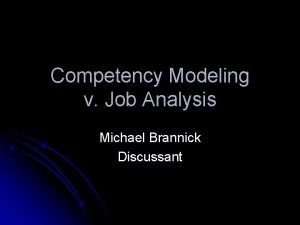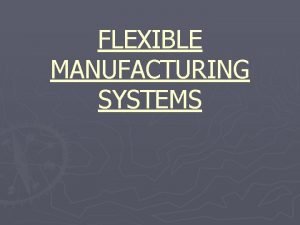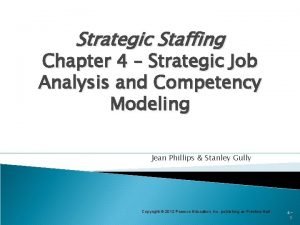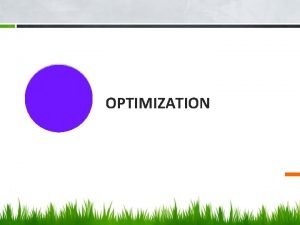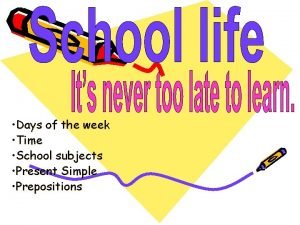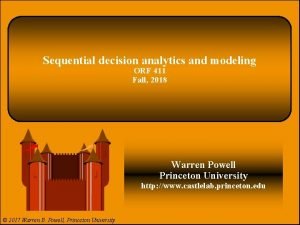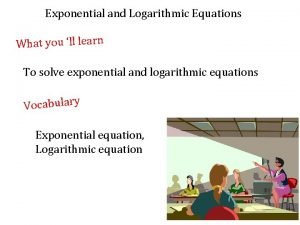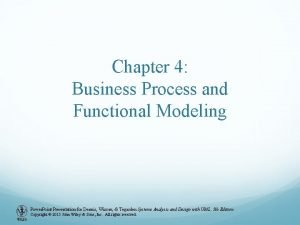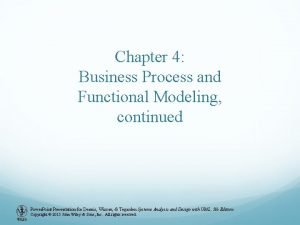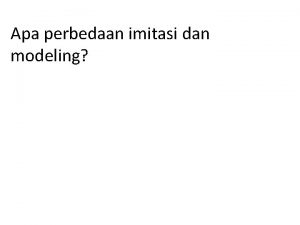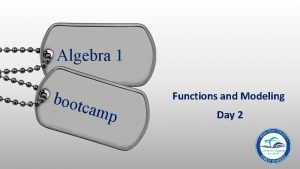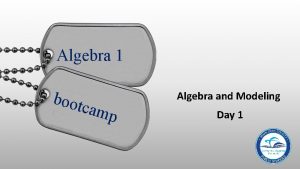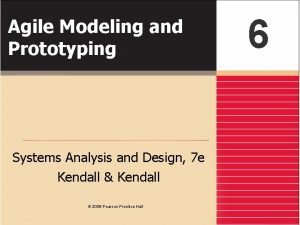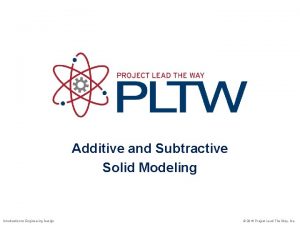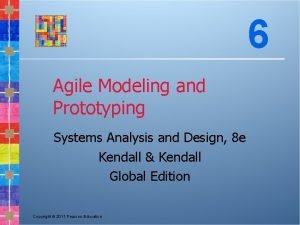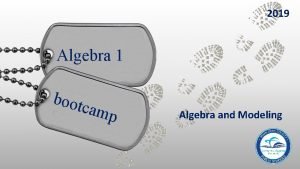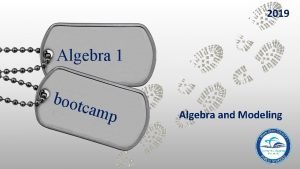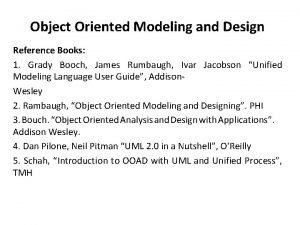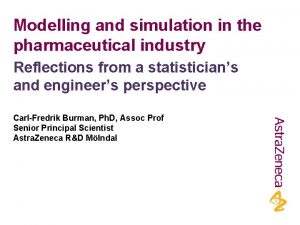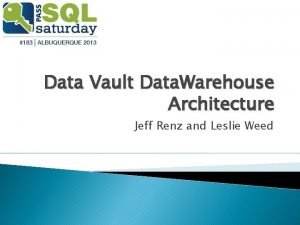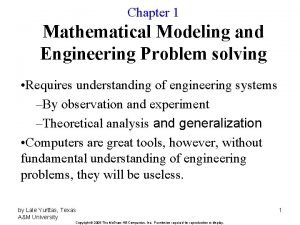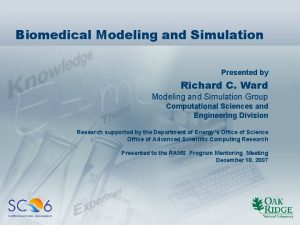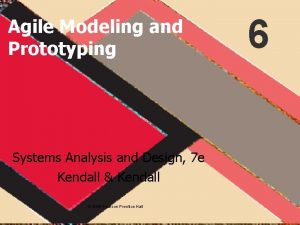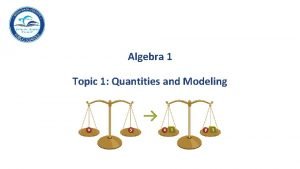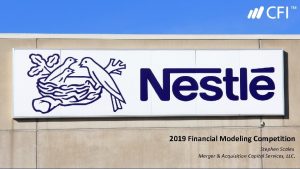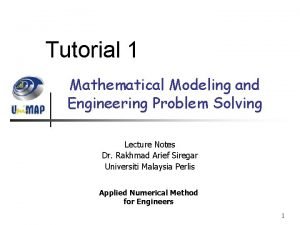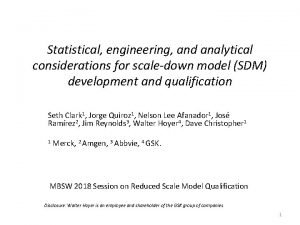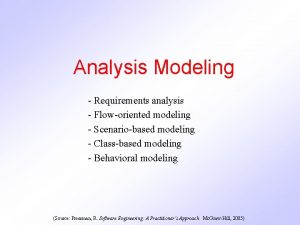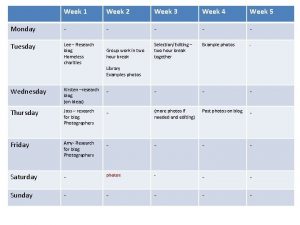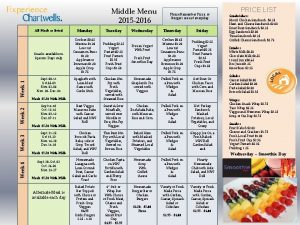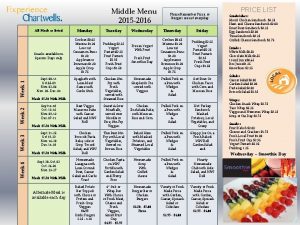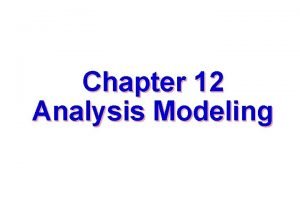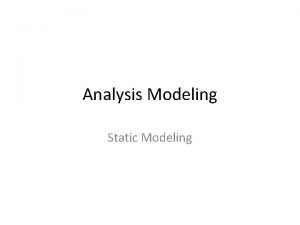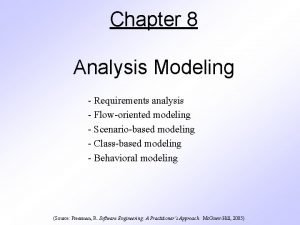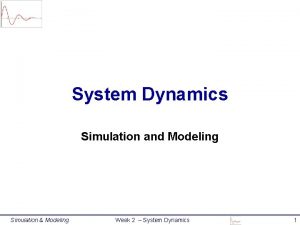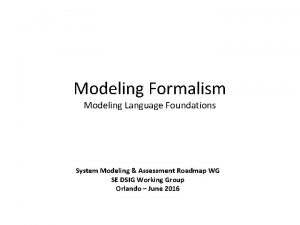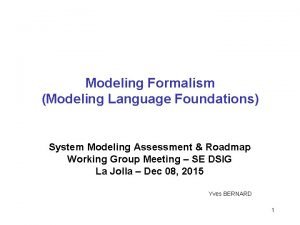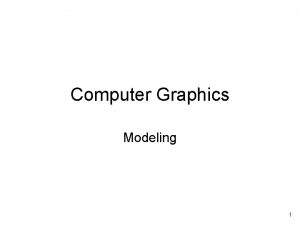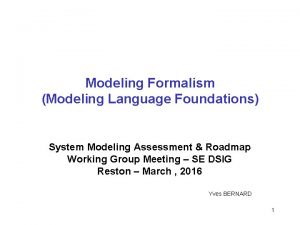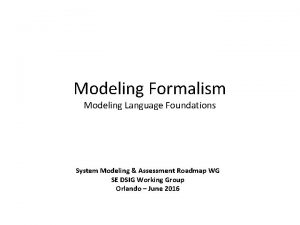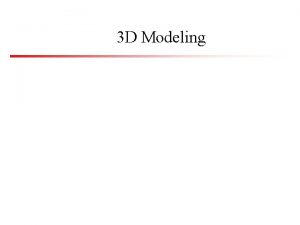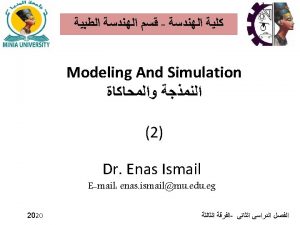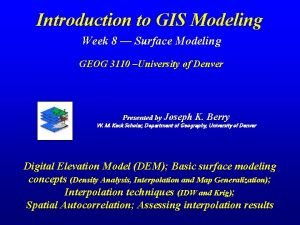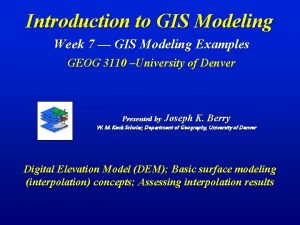Modeling and Analysis Week 8 Modeling and Analysis
















































- Slides: 48

Modeling and Analysis Week 8

Modeling and Analysis Topics n n n n n 2 Modeling for MSS (a critical component) Static and dynamic models Treating certainty, uncertainty, and risk Influence diagrams (in the posted PDF file) MSS modeling in spreadsheets Decision analysis of a few alternatives (with decision tables and decision trees) Optimization via mathematical programming Heuristic programming Simulation Model base management

DSS Modeling n n A key element in most DSS Leads to reduced cost and increased revenue n n Du. Pont Simulates Rail Transportation System and Avoids Costly Capital Expenses Procter & Gamble uses several DSS models collectively to support strategic decisions n n 3 Locating distribution centers, assignment of DCs to warehouses/customers, forecasting demand, scheduling production per product type, etc. Fiat, Pillowtex (…operational efficiency)…

P&G n n Used optimization models to redesign its distribution system Several models used: n n n n 4 Generating model (algorithm) to estimate transportation costs Demand forecasting model (statistics based) Distribution center location model Linear programming transportation model to determine best shipping Financial and risk simulation model that also considers some qualitative factors GIS for a user interface Some built in the DSS some external and some accessed as needed 500 employees involved over the course of a year

AMR n n n 5 Used models to optimize the altitude ascent and descent profile for planes Saved millions in fuel cost per week Part of SABRE system that used models extensively incremental revenues eventually exceeded $1 billion annually

Major Modeling Issues n n Problem identification and environmental analysis (information collection) Variable identification n n Forecasting/predicting n n n 6 More information leads to better prediction Multiple models: A DSS can include several models, each of which represents a different part of the decision-making problem n n Influence diagrams, cognitive maps Categories of models >>> Model management Knowledge based modeling

Influence Diagrams n n Graphical representations of a model “Model of a model” A tool for visual communication Some influence diagram packages create and solve the mathematical model Framework for expressing DSS model relationships Rectangle = a decision variable Circle = uncontrollable or intermediate variable Oval = result (outcome) variable: intermediate or final Variables are connected with arrows indicates the direction of influence (relationship) 7

Influence Diagrams: Relationships The shape of the arrow indicates the type of relationship 8

Influence Diagrams: Example An influence diagram for the profit model Profit = Income – Expense Income = Units. Sold * Unit. Price Units. Sold = 0. 5 * Advertisement Expenses = Units. Cost * Unit. Sold + Fixed. Cost 9

Influence Diagrams: Software n Analytica, Lumina Decision Systems n n Decision. Pro, Vanguard Software Co. n n Integrates influence diagrams and Excel, also supports Monte Carlo simulations Precision. Tree, Palisade Co. n 10 Includes influence diagrams, decision trees and simulation Definitive Scenario, Definitive Software n n Supports hierarchical (tree structured) diagrams DATA Decision Analysis, Tree. Age Software n n Supports hierarchical (multi-level) diagrams Creates influence diagrams and decision trees directly in an Excel spreadsheet

Analytica Influence Diagram of a Marketing Problem: The Marketing Model 11

Analytica: The Price Submodel 12

Analytica: The Sales Submodel 13

Categories of Models Category 14 Objective Techniques Optimization of problems with few alternatives Find the best solution from a small number of alternatives Decision tables, decision trees Optimization via algorithm Find the best solution from a large number of alternatives using a step-by-step process Linear and other mathematical programming models Optimization via an analytic formula Find the best solution in one step using a formula Some inventory models Simulation Find a good enough solution by experimenting with a dynamic model of the system Several types of simulation Heuristics Find a good enough solution using “common-sense” rules Heuristic programming and expert systems Predictive and other models Predict future occurrences, what-if analysis, … Forecasting, Markov chains, financial, …

Static and Dynamic Models n Static Analysis n n Dynamic Analysis n n n 15 Single snapshot of the situation Single interval Steady state Dynamic models Evaluate scenarios that change over time Time dependent Represents trends and patterns over time More realistic: Extends static models

Mathematical Models n 4 basic components n Result variables n n Decision variables n n 16 constraints Intermediate result variables n n Alternative courses of action Uncontrollable variables n n Reflect the level of effectiveness of a system Intermediate outcomes Mathematical relationships link the components together

Examples of the Components of Models 17 Area Decision variables Result variables Uncontrollable variables Financial investment Investment alternatives and amounts Total profit, risk, ROI, EPS, liquidity Inflation rate, prime rate, competition Marketing Ad budget, where to advertise Market share, Customer’s income, customer satisfaction competitor’s actions Manufacturing What and how much to produce, inventory levels Total cost, quality level Machine capacity, material prices Accounting Audit schedule Error rate Tax rates, legal requirements Transportation Shipments schedule, use of smart cards Total transportation cost Delivery distance, regulations Services Staffing levels Customer satisfaction Demand for services

Certainty, Uncertainty and Risk 18

Decision Making: Treating Certainty, Uncertainty and Risk n Certainty Models n n Uncertainty n n Several outcomes for each decision Probability of each outcome is unknown Knowledge would lead to less uncertainty Risk analysis (probabilistic decision making) n n 19 Assume complete knowledge All potential outcomes are known May yield optimal solution Probability of each of several outcomes occurring Level of uncertainty => Risk (expected value)

DSS Modeling with Spreadsheets n n n Spreadsheet: most popular end-user modeling tool Flexible and easy to use Powerful functions n n n n 20 Add-in functions and solvers Programmability (via macros) What-if analysis Goal seeking Simple database management Seamless integration of model and data Incorporates both static and dynamic models Examples: Microsoft Excel, Lotus 1 -2 -3

Excel spreadsheet - static model example: Simple loan calculation of monthly payments 21

Excel spreadsheet Dynamic model example: Simple loan calculation of monthly payments and effects of prepayment 22

Decision Analysis: A Few Alternatives Single Goal Situations Decision tables n n n Decision trees n n 23 Multiple criteria decision analysis Features include decision variables (alternatives), uncontrollable variables, result variables Graphical representation of relationships Multiple criteria approach Demonstrates complex relationships Cumbersome, if many alternatives exists

Decision Tables n Investment example n One goal: maximize the yield after one year n Yield depends on the status of the economy (the state of nature) n n n 24 Solid growth Stagnation Inflation

Investment Example: Possible Situations 1. If solid growth in the economy, bonds yield 12%; stocks 15%; time deposits 6. 5% 2. If stagnation, bonds yield 6%; stocks 3%; time deposits 6. 5% 3. If inflation, bonds yield 3%; stocks lose 2%; time deposits yield 6. 5% 25

Investment Example: Decision Table n Payoff Decision variables (alternatives) Uncontrollable variables (states of economy) Result variables (projected yield) n Tabular representation: n n 26

Investment Example: Treating Uncertainty n n n Optimistic approach Pessimistic approach Treating Risk: n n 27 Use known probabilities Risk analysis: compute expected values

Decision Analysis: A Few Alternatives n Other methods of treating risk n n Multiple goals n 28 Simulation, Certainty factors, Fuzzy logic Yield, safety, and liquidity

DSS Mathematical Models n Non-Quantitative Models (Qualitative) n n Captures symbolic relationships between decision variables, uncontrollable variables and result variables Quantitative Models: Mathematically links decision variables, uncontrollable variables, and result variables n n n Decision variables describe alternative choices. Uncontrollable variables are outside decision-maker’s control Result variables are dependent on chosen combination of decision variables and uncontrollable variables t en d en p e Ind Decision Variables 29 les b ria Va Uncontrollable Variables Dependent Variables Mathematical Relationships Intermediate Variables Result Variables

Optimization via Mathematical Programming n Mathematical Programming A family of tools designed to help solve managerial problems in which the decision maker must allocate scarce resources among competing activities to optimize a measurable goal n Optimal solution: The best possible solution to a modeled problem n 30 Linear programming (LP): A mathematical model for the optimal solution of resource allocation problems. All the relationships are linear

LP Problem Characteristics 1. Limited quantity of economic resources 2. Resources are used in the production of products or services 3. Two or more ways (solutions, programs) to use the resources 4. Each activity (product or service) yields a return in terms of the goal 5. Allocation is usually restricted by constraints 31

Linear Programming Steps n 1. Identify the … n n Decision variables Objective function coefficients Constraints n n 2. Represent the model n n n 32 Capacities / Demands LINDO: Write mathematical formulation EXCEL: Input data into specific cells in Excel 3. Run the model and observe the results Line

LP Example The Product-Mix Linear Programming Model n n MBI Corporation Decision: How many computers to build next month? Two types of mainframe computers: CC 7 and CC 8 Constraints: Labor limits, Materials limit, Marketing lower limits CC 7 CC 8 Labor (days) 300 500 Materials ($) 10, 000 15, 000 Units 1 Profit ($) 8, 000 12, 000 Rel <= <= >= >= Max Limit 200, 000 /mo 8, 000 /mo 100 200 Objective: Maximize Total Profit / Month 33

LP Solution 34

LP Solution n 35 Decision Variables: X 1: unit of CC-7 X 2: unit of CC-8 Objective Function: Maximize Z (profit) Z=8000 X 1+12000 X 2 Subject To 300 X 1 + 500 X 2 200 K 10000 X 1 + 15000 X 2 8000 K X 1 100 X 2 200

Sensitivity, What-if, and Goal Seeking Analysis n Sensitivity n n What-if n n Assesses solutions based on changes in variables or assumptions (scenario analysis) Goal seeking n n n 36 Assesses impact of change in inputs on outputs Eliminates or reduces variables Can be automatic or trial and error Backwards approach, starts with goal Determines values of inputs needed to achieve goal Example is break-even point determination

Heuristic Programming n n Cuts the search space Gets satisfactory solutions more quickly and less expensively Finds good enough feasible solutions to very complex problems Heuristics can be n n n 37 Quantitative Qualitative (in ES) Traveling Salesman Problem >>>

Heuristic Programming - SEARCH 38

Traveling Salesman Problem n What is it? n n 39 A traveling salesman must visit customers in several cities, visiting each city only once, across the country. Goal: Find the shortest possible route Total number of unique routes (TNUR): TNUR = (1/2) (Number of Cities – 1)! Number of Cities TNUR 5 12 6 60 9 20, 160 20 1. 22 1018

When to Use Heuristics n n n Inexact or limited input data Complex reality Reliable, exact algorithm not available Computation time excessive For making quick decisions Limitations of Heuristics n 40 Cannot guarantee an optimal solution

Simulation n n 41 Technique for conducting experiments with a computer on a comprehensive model of the behavior of a system Frequently used in DSS tools

Major Characteristics of Simulation n n ! 42 Imitates reality and capture its richness Technique for conducting experiments Descriptive, not normative tool Often to “solve” very complex problems Simulation is normally used only when a problem is too complex to be treated using numerical optimization techniques

Advantages of Simulation n n n n 43 The theory is fairly straightforward Great deal of time compression Experiment with different alternatives The model reflects manager’s perspective Can handle wide variety of problem types Can include the real complexities of problems Produces important performance measures Often it is the only DSS modeling tool for non -structured problems

Limitations of Simulation n n 44 Cannot guarantee an optimal solution Slow and costly construction process Cannot transfer solutions and inferences to solve other problems (problem specific) So easy to explain/sell to managers, may lead overlooking analytical solutions Software may require special skills

Simulation Methodology n n Model real system and conduct repetitive experiments. Steps: 1. 2. 3. 4. 45 Define problem Construct simulation model Test and validate model Design experiments 5. Conduct experiments 6. Evaluate results 7. Implement solution

Simulation Types n Stochastic vs. Deterministic Simulation n n Time-dependent vs. Time-independent Simulation n Time independent stochastic simulation via Monte Carlo technique (X = A + B) n Discrete event vs. Continuous simulation n Simulation Implementation n 46 In stochastic simulations: We use distributions (Discrete or Continuous probability distributions) Visual simulation

Visual Interactive Modeling (VIM) / Visual Interactive Simulation (VIS) n Visual interactive modeling (VIM) Also called n n n n 47 Visual interactive problem solving Visual interactive modeling Visual interactive simulation Uses computer graphics to present the impact of different management decisions Often integrated with GIS Users perform sensitivity analysis Static or a dynamic (animation) systems

Model Base Management n n MBMS: capabilities similar to that of DBMS But, there are no comprehensive model base management packages Each organization uses models somewhat differently There are many model classes n n n 48 Within each class there are different solution approaches Relations MBMS Object-oriented MBMS
 Week by week plans for documenting children's development
Week by week plans for documenting children's development Helen erickson nursing theory
Helen erickson nursing theory Relational modeling vs dimensional modeling
Relational modeling vs dimensional modeling Simulation modeling and analysis law kelton
Simulation modeling and analysis law kelton What is process modeling in system analysis and design
What is process modeling in system analysis and design System requirements checklist output example
System requirements checklist output example Job analysis vs competency modeling
Job analysis vs competency modeling Manufacturing systems modeling and analysis
Manufacturing systems modeling and analysis Job analysis in staffing
Job analysis in staffing Dfd chapter 5
Dfd chapter 5 Linear and quadratic functions and modeling
Linear and quadratic functions and modeling Dfd chapter 5
Dfd chapter 5 A company manufactures and sells x cellphones per week
A company manufactures and sells x cellphones per week Pros and cons of four day school week
Pros and cons of four day school week Days of the week and months of the year
Days of the week and months of the year School subjects and days of the week
School subjects and days of the week Timeline of romeo and juliet
Timeline of romeo and juliet Sequential decision analytics
Sequential decision analytics Modeling with exponential and logarithmic equations quiz
Modeling with exponential and logarithmic equations quiz Business process and functional modeling
Business process and functional modeling Business process and functional modeling
Business process and functional modeling Modeling and imitation training aba
Modeling and imitation training aba Pertanyaan tentang teori albert bandura
Pertanyaan tentang teori albert bandura Algebra 1 bootcamp functions and modeling answer key
Algebra 1 bootcamp functions and modeling answer key Algebra 1 boot camp
Algebra 1 boot camp Algebra 1 bootcamp functions and modeling
Algebra 1 bootcamp functions and modeling Patched-up prototype
Patched-up prototype Additive and subtractive modeling
Additive and subtractive modeling Patched-up prototype
Patched-up prototype Algebra 1 bootcamp algebra and modeling
Algebra 1 bootcamp algebra and modeling Algebra bootcamp answers
Algebra bootcamp answers Object oriented modeling and design books
Object oriented modeling and design books Pharmaceutical simulation and modeling
Pharmaceutical simulation and modeling Introduction to modeling and simulation
Introduction to modeling and simulation Jeff renz
Jeff renz Mathematical modeling and engineering problem solving
Mathematical modeling and engineering problem solving Biomedical modeling and simulation
Biomedical modeling and simulation Device modeling for analog and rf cmos circuit design
Device modeling for analog and rf cmos circuit design What is the primary goal in agile modeling
What is the primary goal in agile modeling Subtractive modeling definition
Subtractive modeling definition Apa itu simulasi
Apa itu simulasi Computational engineering and physical modeling
Computational engineering and physical modeling Geometric modeling in probability and statistics
Geometric modeling in probability and statistics Quantities and modeling algebra 1
Quantities and modeling algebra 1 Merger and acquisition financial modeling
Merger and acquisition financial modeling Softwares can_ -in designing and modeling in every field
Softwares can_ -in designing and modeling in every field Mathematical modeling and engineering problem solving
Mathematical modeling and engineering problem solving Site:slidetodoc.com
Site:slidetodoc.com Image-based modeling and rendering
Image-based modeling and rendering






